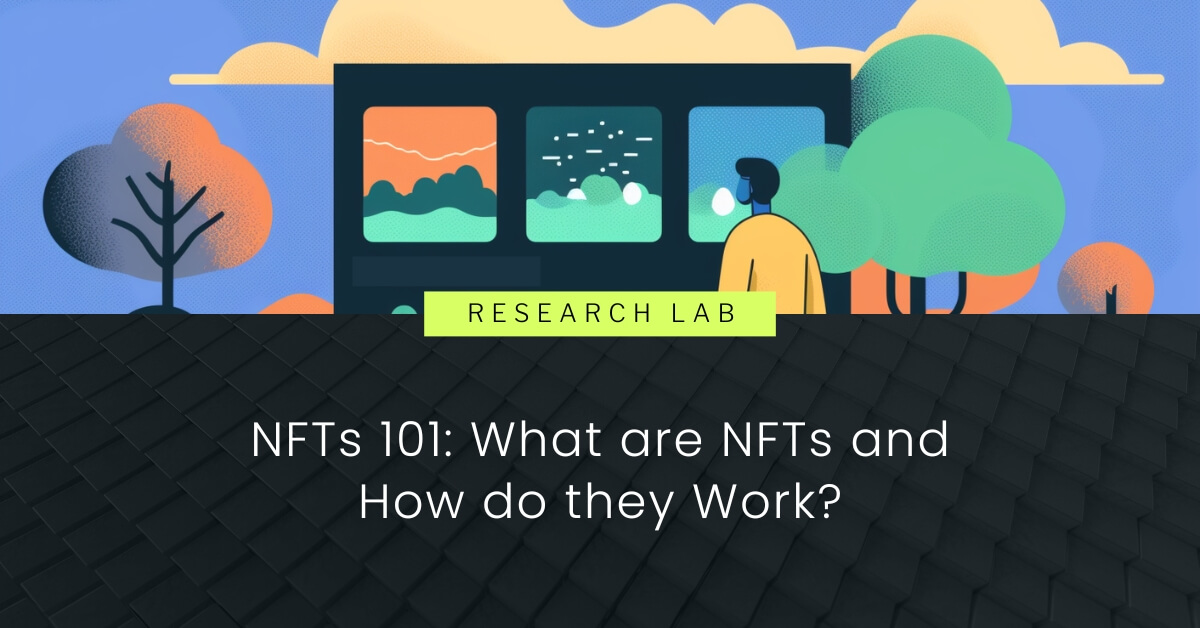Content
- Blockchain and Fungible Tokens
- Non-Fungible Tokens (NFTs)
- The On-Chain Difference Between NFTs and Fungible Tokens
- Use Cases of NFTs
- How NFTs Herald Digital Ownership
- Conclusion
- DISCLAIMER
- FAQs
- What are Non-Fungible Tokens (NFTs)?
- What is the difference between Fungible Tokens and NFTs?
- What are some use cases of NFTs?
- How do NFTs enable digital ownership?
- What is the future of NFTs?
27 Feb, 23
NFTs 101: What are NFTs and How do they Work?

- Blockchain and Fungible Tokens
- Non-Fungible Tokens (NFTs)
- The On-Chain Difference Between NFTs and Fungible Tokens
- Use Cases of NFTs
- How NFTs Herald Digital Ownership
- Conclusion
- DISCLAIMER
- FAQs
- What are Non-Fungible Tokens (NFTs)?
- What is the difference between Fungible Tokens and NFTs?
- What are some use cases of NFTs?
- How do NFTs enable digital ownership?
- What is the future of NFTs?
In the world of Non-Fungible Tokens (NFTs) uniqueness is king and ownership reigns supreme. A land where digital art, collectibles, and memories can be forever captured and preserved, never to be replicated or duplicated. The key that unlocks doors to this world is blockchain technologies, allowing for the creation of NFTs. Through this door, the ownership of a single pixel can hold as much value as a rare masterpiece. Beyond this, NFTs enable many unique utilities on the blockchain, including tokenisation, on-chain data storage, gaming and more. With its limitless potential, the rise of NFTs holds the promise of revolutionising the way we think about ownership and are often viewed to be at the forefront of mainstream adoption of blockchains.

Blockchain and Fungible Tokens
The launch of the Ethereum blockchain in 2015 entirely altered the trajectory of the blockchain; the revolution was not related to consensus, execution speed or transaction throughput, but instead the ability to deploy smart contracts. Smart contracts act as autonomously, self-executing computer programs that function based on the terms of the contract upon predetermined conditions being met. Upon Ethereum being able to support the execution of smart contracts, many more tokens began to populate the ecosystem. Previously, a project would need to launch its own blockchain and obtain a secure validator set when launching a token. Ethereum smart contracts, namely the ERC-20 contract, shifted the narrative.
The capacity for projects to easily and efficiently launch a cryptocurrency was novel and led to the ICO boom of 2017/2018. Tokens could be made to represent any fungible item, including gold, currencies, shares, real estate and many more. Accordingly, thousands of tokens were launched during this period; all of which were fungible. ERC-20 tokens are not unique – each is the same in the eyes of the blockchain. Although the holders of the token can be different, fundamentally, they are the same. As a result, these types of tokens can be efficiently traded and used throughout the decentralised finance (DeFi) space.
Non-Fungible Tokens (NFTs)
Despite the huge leap forward made by ERC-20 contracts and fungible tokens, their very nature resulted in Ethereum and other blockchains with smart contract functionality being unable to store unique data. In this way, many potential benefits that were to be brought up by blockchains were locked without non-fungibility.
To resolve this, a new token standard, ERC-721s, was created – bringing to the world NFTs; as a token that could be used to identify unique, distinct objects, information, data and real-world objects. No longer did the limitation of fungibility operate as a shackle on the use cases on blockchains. Whilst two NFTs could be the same if a developer intended this to be the case, inherently, 1:1 NFTs, whereby each is independent of the other, were never repeated.
Nonetheless, although NFTs brought about a new wave of use cases and applications of blockchain technologies, they are not without their shortcomings. Fungible tokens are substantially more liquid given they can be used for token-based mechanisms for value capture, distribution of ownership and allocating resources to communities. NFTs, on the other hand, are less illiquid, resulting in their prices fluctuating less and accordingly more challenging to trade. Attempts have been made to abstract NFTs, making them more akin to fungible tokens. The ERC-1155 smart contract, known as the multi-token standard, allows for the combination of fungible and non-fungible tokens. Irrespective of this innovation, ERC-721s have received more adoption and usage in comparison to ERC-1155 tokens.
The On-Chain Difference Between NFTs and Fungible Tokens
As expressed, NFTs and fungible tokens are fundamentally very similar. In fact, there is only one feature in the coding of ERC-721 tokens that separates them from ERC-20 tokens, rendering them non-fungible and unique. This difference is a smart contract’s tokenId. This one variable must be globally unique, meaning that no other smart contract with the same variables can be consistent with respect to the tokenId. With the use of this value, projects can utilise converters that leverage the input number to output images, real items, in-game items and much more.
Use Cases of NFTs
Since the implementation of ERC-721s in 2018, many use cases have evolved out of NFTs. The first dominant NFT project to generate a public groundswell of opinion relating to the technology was CryptoKitties. Centred around breeding collectible NFTs, CryptoKitties gained traction through scarcity; each cat is one-of-a-kind and owned by the holder. This game set the spark of NFT games alight, setting a precedent to be followed years into the future. Other games leveraging NFT technology to function include Axie Infinity, Gods Unchained and StepN.
Furthermore, NFTs brought identity to Ethereum. This was achieved in two primary ways. These unique tokens gradually become a social statement; individuals, celebrities and companies would set their social media profile pictures to their NFT. Many began purchasing exorbitant NFTs purely as a means to show off in the digital world. Collections like CryptoPunks and Bored Ape Yacht Club (BAYC) quickly grew to fame and presently have a respective total trading volume of over 1.1 million ETH and roughly 714 million ETH. Additionally, identity came from projects like Ethereum Name Services (ENS) and Unstoppable Domains which were able to provide an on-chain name that connected with a user’s wallet. At the technical level, these names were represented as NFTs, more specifically, ERC-721 tokens.
How NFTs Herald Digital Ownership
Until blockchains allowed users to hold and store their own tokens through distributed verifiability – that is, the consensus amongst a diverse set of validators – all data and in-game items were owned by companies, conglomerates and enterprises. Games, social media platforms, profiles and all other internet applications were hosted by a single company through the use of centralised servers. These offer a cheaper solution given the absence of a need to incentivise and coordinate consensus across a plethora of validators. However, this meant that companies put up walls between different platforms and games, preventing interoperability. Users could not move their assets or profiles from one platform to the other as they did not have true ownership. This issue, manifesting itself in the form of Blizzard removing a spell in the World of Warcraft in 2010, was what prompted Vitalik Buterin, the co-founder of Ethereum, to build the decentralised network.
Unlike the web2 world where companies are encouraged to act as walled gardens rather than open ecosystems, with the blockchain, digital ownership can be established. If Alice holds 5 ETH and Bob holds 2 BAYC NFTs, they will be able to prove it via a blockchain consensus algorithm. No longer do they hold an item that is stored on a centralised server and accordingly, fundamentally controlled by the entity hosting the server. NFTs allow for objects, in-game objects, digital collectibles and much more to be truly owned as items on the blockchain. In this sense, for the first time since the establishment of the internet, digital ownership is possible.
Conclusion
In conclusion, the emergence of NFTs has introduced a new chapter in the story of ownership, where the unique and one-of-a-kind are celebrated and elevated to a level never before seen. NFTs can be used to represent a number of different types of assets, acting as a bridge between the blockchain and real-world items and objects. As the technology and infrastructure surrounding NFTs continue to evolve, it will likely lead to the proliferation of new and innovative use cases.
DISCLAIMER
Zerocap Pty Ltd carries out regulated and unregulated activities.
Spot crypto-asset services and products offered by Zerocap are not regulated by ASIC. Zerocap Pty Ltd is registered with AUSTRAC as a DCE (digital currency exchange) service provider (DCE100635539-001).
Regulated services and products include structured products (derivatives) and funds (managed investment schemes) are available to Wholesale Clients only as per Sections 761GA and 708(10) of the Corporations Act 2001 (Cth) (Sophisticated/Wholesale Client). To serve these products, Zerocap Pty Ltd is a Corporate Authorised Representative (CAR: 001289130) of AFSL 340799
All material in this website is intended for illustrative purposes and general information only. It does not constitute financial advice nor does it take into account your investment objectives, financial situation or particular needs. You should consider the information in light of your objectives, financial situation and needs before making any decision about whether to acquire or dispose of any digital asset. Investments in digital assets can be risky and you may lose your investment. Past performance is no indication of future performance.
FAQs
What are Non-Fungible Tokens (NFTs)?
Non-Fungible Tokens (NFTs) are unique digital assets that are stored on a blockchain. They are unique and cannot be replicated or duplicated. NFTs can represent digital art, collectibles, and other digital assets. They are created using blockchain technologies and can enable many unique utilities, including tokenisation, on-chain data storage, gaming, and more.
What is the difference between Fungible Tokens and NFTs?
Fungible tokens, like ERC-20 tokens on the Ethereum blockchain, are not unique. Each token is the same in the eyes of the blockchain. On the other hand, NFTs, represented as ERC-721 tokens, are unique. Each NFT is independent of the other and is never repeated, meaning each NFT can represent a unique digital or real-world asset.
What are some use cases of NFTs?
NFTs have a wide range of use cases. They can be used in games like CryptoKitties, Axie Infinity, Gods Unchained, and StepN, where each token represents a unique in-game item. NFTs can also represent digital collectibles, with collections like CryptoPunks and Bored Ape Yacht Club gaining significant popularity. Other use cases include representing real-world objects, digital ownership, and even identity on the blockchain.
How do NFTs enable digital ownership?
NFTs enable digital ownership by allowing users to hold and store their own tokens through distributed verifiability. Unlike traditional digital assets that are stored on centralized servers and controlled by companies, NFTs are stored on a blockchain and controlled by the holder of the token. This means that the holder of an NFT truly owns that asset.
What is the future of NFTs?
The future of NFTs holds great potential. As the technology and infrastructure surrounding NFTs continue to evolve, it is expected to lead to the proliferation of new and innovative use cases. NFTs are already changing the way we think about ownership and are at the forefront of mainstream adoption of blockchains. With the ability to represent a wide range of unique digital and real-world assets, the possibilities for NFTs are virtually limitless.
Like this article? Share
Latest Insights
What is the Base Blockchain? The Coinbase Layer 2
The Base blockchain, introduced by Coinbase, represents a significant development in the realm of cryptocurrency and blockchain technology. It is a layer-2 solution built on
Bitcoin Mining in the US: Main Challenges
Bitcoin mining in the United States has recently faced a range of challenges, from regulatory hurdles to community and environmental concerns. As a significant hub
Bitcoin Halving: Market Reacts
The 2024 Bitcoin halving, a significant event for the cryptocurrency world, marked a notable shift in the market dynamics of Bitcoin. As the block reward
Receive Our Insights
Subscribe to receive our publications in newsletter format — the best way to stay informed about crypto asset market trends and topics.



 Share
Share  Tweet
Tweet  Post
Post 